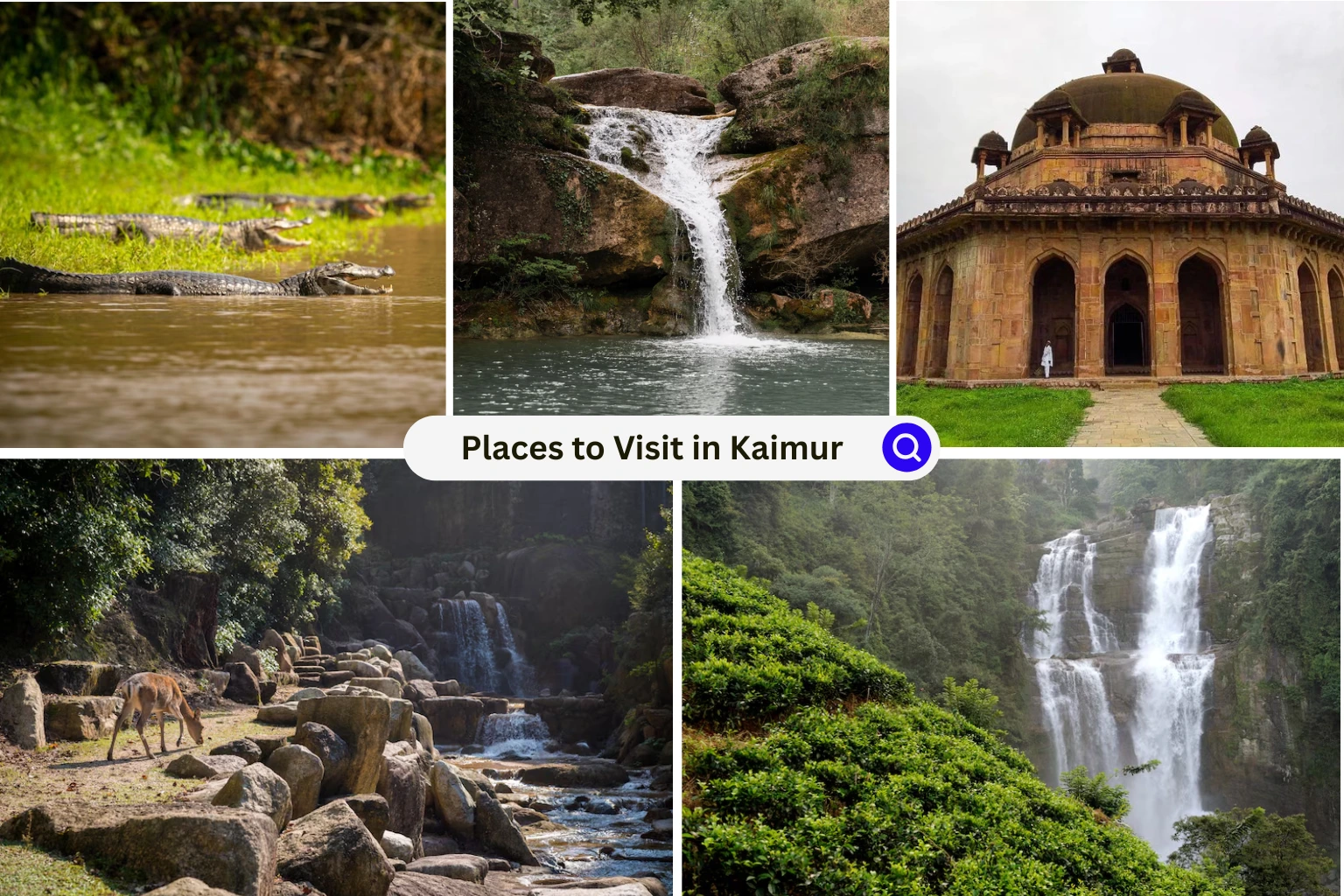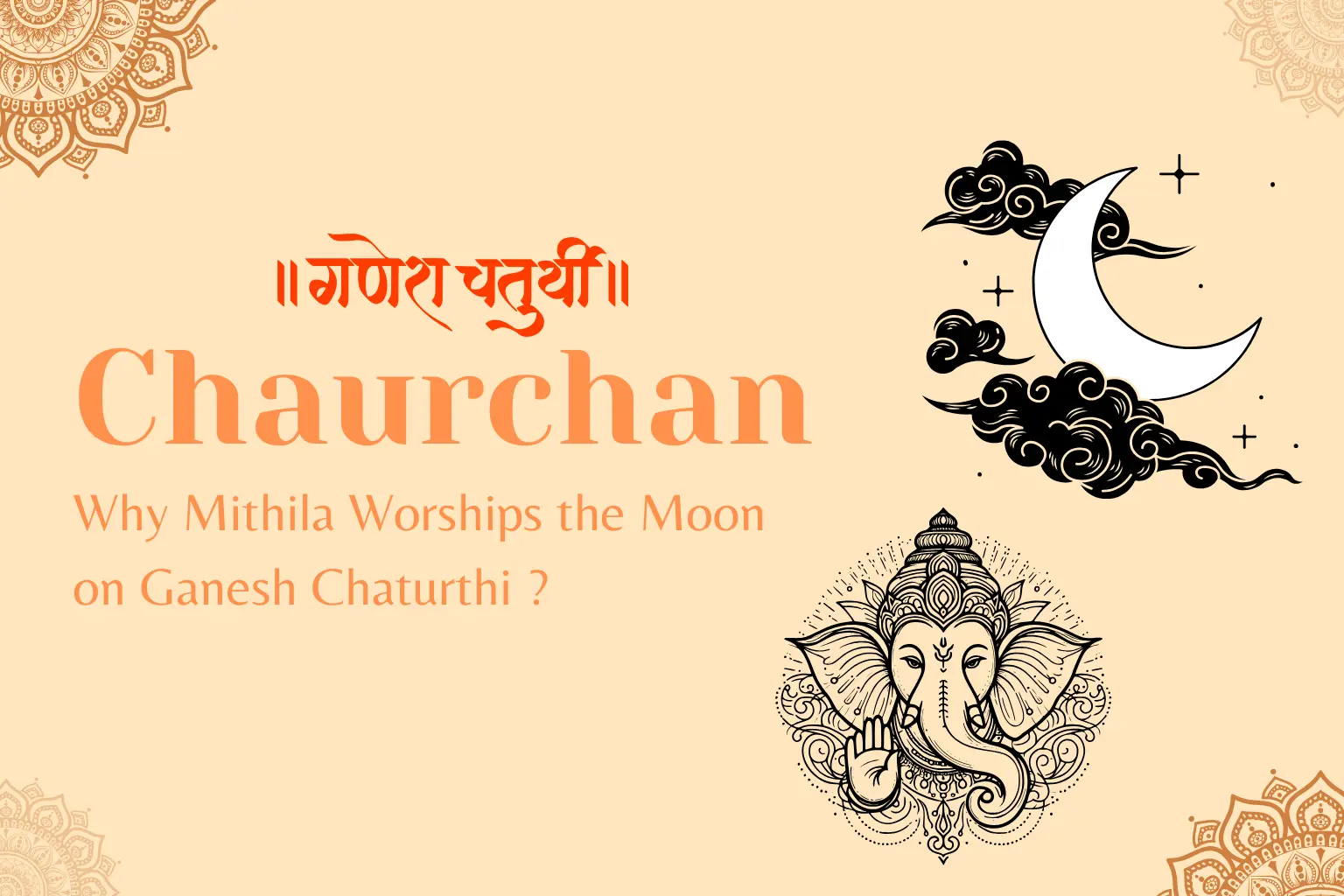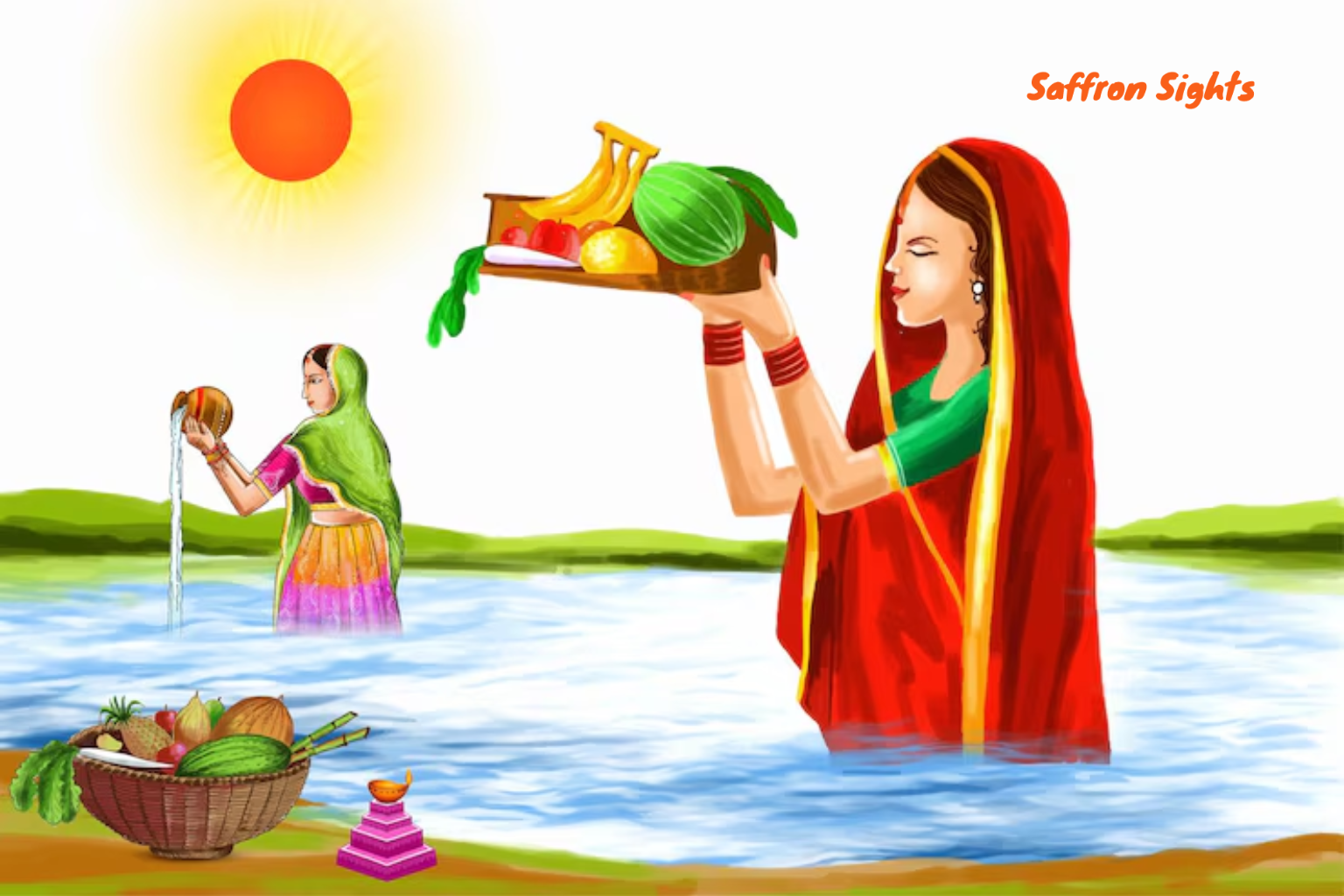Do you want to see big waterfalls, wild animals, old forts, and even crocodiles? Then Kaimur is the place to go!
Kaimur is a beautiful district in Bihar that many people don’t know much about. But it has so many amazing things to see and learn. There are tall waterfalls, thick forests, wild animals, and old historical places that tell us stories from the past.
This guide will help you explore five of the best places in Kaimur:
- Kaimur Wildlife Sanctuary – The biggest forest area in Bihar, full of animals and birds
- Telhar Kund Waterfall – A tall and powerful waterfall, perfect for photos and picnics
- Karkatgarh Crocodile Sanctuary – A special place to see real crocodiles in the wild
- Karkatgarh Waterfall – A peaceful and beautiful spot hidden in the forest
- Tomb of Bakhtiyar Khan – A historical tomb built in the Mughal style
These places are not only fun to visit but also full of interesting facts for school students and job aspirants. So, let’s start the journey and learn more about the wonders of Kaimur!
1. Kaimur Wildlife Sanctuary
About the Place
Kaimur Wildlife Sanctuary is the largest sanctuary in Bihar. It was established in 1979 and covers parts of the Kaimur and Rohtas districts. The sanctuary lies in the Kaimur hill range and has many types of forests, including sal, bamboo, and mixed deciduous trees.
The region is not only about nature. It also features ancient sites such as Rohtasgarh Fort, Shergarh Fort, cave paintings from old, and prehistoric stone buildings. These provide insight into what life was like for early humans.
What You Can See
- Animals like Bengal tigers, leopards, bears, deer, and many birds live here.
- In winter, many migratory birds also come to this area.
- The sanctuary has waterfalls like Karkat and Telhar, deep valleys, and streams.
Things to Do
Visitors can enjoy a wildlife safari, birdwatching, trekking, nature photography, and exploring ancient caves.
Best Time to Visit
From October to March for wildlife and pleasant weather. The monsoon season (June to August) is also suitable for seeing waterfalls and green forests.
How to Reach
- Nearest airport: Varanasi (112 km)
- Nearest railway stations: Bhabua Road, Sasaram, and Dehri-on-Son
- Guesthouses are available at Harrah, Mahuaria, and Churk through the forest department.
Interesting Fact
This sanctuary is home to ancient rock art and megaliths that show how early people lived thousands of years ago.
2. Telhar Kund Waterfall
About the Place
Telhar Kund is a tall waterfall, about 80 meters high. It is located around 25 km from Bhabua in the Kaimur hills. This waterfall becomes very active during and after the rainy season.
What You Can See
The area is surrounded by thick forests and green hills, making it a peaceful spot for nature lovers.
Things to Do
You can enjoy sightseeing, photography, and picnics. The walk from the parking area to the waterfall is about 300 meters.
Best Time to Visit
From June to December, especially after heavy rains, the waterfall looks most beautiful.
How to Reach
- Nearest railway station: Mohania (Bhabua Road)
- You can reach the spot by road from Bhabua.
Interesting Fact
The National Hydro Electric Power Corporation has studied Telhar Kund for generating electricity from its water power.
3. Karkatgarh Crocodile Sanctuary
About the Place
This sanctuary is set up near Karkatgarh Waterfall to protect the mugger crocodile, which is native to India. The area has a natural habitat of rocky rivers, thick forests, and clean streams.
What You Can See
It is a good place to observe crocodiles and other forest wildlife in their natural environment.
Things to Do
Tourists can go on guided nature walks, watch crocodiles from a safe distance, and enjoy birdwatching.
Best Time to Visit
Winter and the post-monsoon season are the best times to visit, when the water level is high and the animals are more active.
How to Reach
It is accessible by road from Bhabua and nearby towns.
Interesting Fact
The sanctuary plays an important role in saving mugger crocodiles and teaching people about the value of wetlands.
4. Karkatgarh Waterfall
About the Place
Karkatgarh Waterfall is a quiet and scenic waterfall inside the Kaimur Wildlife Sanctuary. It is not as crowded as other spots, making it perfect for a peaceful trip.
What You Can See
The waterfall is surrounded by green forests and rock hills, creating a very calm and natural setting.
Things to Do
You can enjoy trekking, nature walks, and taking beautiful photos. It is advised to take a local guide for a safe journey through forest paths.
Best Time to Visit
Between July and December, especially after the rains.
Interesting Fact
Since the Karkatgarh Crocodile Sanctuary is nearby, visitors can explore both places in one trip.
5. Tomb of Bakhtiyar Khan
About the Place
This historical tomb belongs to Bakhtiyar Khan, an important figure from the Mughal period. It is built in the Indo-Islamic architectural style.
What You Can See
The tomb shows detailed Mughal-era design and is a good example of historical art and architecture.
Things to Do
You can take a guided tour to learn about the history and take photos of the monument.
Best Time to Visit
From October to March, when the weather is good.
How to Reach
Located near Bhabua and easily accessible by road.
Interesting Fact
The tomb symbolizes the region’s rich cultural and historical past. It helps us learn how people built grand structures hundreds of years ago.
Summary Table
| Place | Best Time to Visit | Special Features | Activities |
| Kaimur Wildlife Sanctuary | October–March, Monsoon | Ancient forts, forest, and rock art | Safari, birdwatching, trekking |
| Telhar Kund Waterfall | June–December | 80-meter waterfall, lush forest | Picnics, sightseeing, photography |
| Karkatgarh Crocodile Sanctuary | Winter, Post-monsoon | Home to mugger crocodiles, wetlands | Wildlife viewing, nature walks |
| Karkatgarh Waterfall | July–December | Scenic, peaceful, near crocodile area | Trekking, nature walks, photography |
| Tomb of Bakhtiyar Khan | October–March | Mughal-era tomb, historical site | Heritage tours, photography |
Ready to Explore Kaimur? Let the Journey Begin!
Kaimur is not just a place—it’s an experience full of forests, waterfalls, wild animals, old forts, and stories from history. Whether you’re a student learning for your GK exams, a traveler looking for peaceful nature, or someone who loves old buildings and ancient art, Kaimur has something special for everyone.
So, what are you waiting for?
Plan a trip, pack your bags, or just read and learn more about this amazing district.
And who knows—you might even discover a new fact or story to share in your next class, quiz, or interview!
Keep exploring. Keep learning. Kaimur is calling!
Frequently Asked Questions
1. What is the old name of Kaimur?
Kaimur’s old name was Bhabua. Even today, the district headquarters of Kaimur is called Bhabua, and the main railway station is known as Bhabua Road (Mohania).
2. What is Kaimur famous for?
Kaimur is known for its rich natural beauty, wildlife, historical forts, ancient rock art, waterfalls, and cultural heritage. It’s home to Kaimur Wildlife Sanctuary, Telhar Kund Waterfall, Karkatgarh Crocodile Sanctuary, and historic sites like the Tomb of Bakhtiyar Khan.
3. What are the most breathtaking natural features of Kaimur Waterfalls and Telhar Kund?
Thick green forests and rocky hills surround both waterfalls. Telhar Kund is an 80-meter-high waterfall that looks most beautiful during and after the monsoon. Karkatgarh Waterfall is more peaceful and tucked inside the forest, incredible for nature lovers.
4. How does the historical significance of Bakhtiyar Khan’s tomb enhance its cultural value?
The tomb reflects Mughal-style architecture and represents the region’s Islamic heritage. It gives a glimpse of Kaimur’s connection with the Mughal period, making it important for history lovers and researchers.
5. When is the best time to visit Karkatgarh Crocodile Sanctuary for wildlife viewing?
The best time to visit is in the winter and post-monsoon months (October to February) when water levels are good and crocodiles can often be seen basking in the sun.
6. What unique flora and fauna can I expect at Kaimur Wildlife Sanctuary during my visit?
The sanctuary has sal, teak, bamboo, mahua, and Jamun trees. In winter, you may spot tigers, leopards, sloth bears, sambar deer, nilgai (blue bulls), and over 70 types of birds.
7. How do visitor tips vary between exploring Karkatgarh Waterfall and Telhar Kund Waterfall?
- Telhar Kund has a proper path and is more visited, especially during the monsoon. It requires a short 300m walk.
- Karkatgarh Waterfall is inside a forest and needs trekking or local guidance. It’s more peaceful but not crowded.
Both are beautiful, but Telhar is more developed for casual tourists.
8. How can I reach Kaimur from major cities like Varanasi or Patna?
- From Varanasi (112 km), you can travel by road or train to Mohania (Bhabua Road).
- From Patna (around 200 km): Trains and buses are available. The nearest railway stations are Bhabua Road, Sasaram, and Dehri-on-Son.
9. Are there any entry fees or permits required to visit Kaimur Wildlife Sanctuary?
There is no entry fee, and the sanctuary is open all year round. However, you may need to book a safari or guesthouse stay with the forest department.
10. What kind of animals can be spotted during a safari in Kaimur Wildlife Sanctuary?
You may see tigers, leopards, deer (like sambar and chital), wild boar, sloth bears, and many bird species. Morning and late afternoon are the best times to spot wildlife.
11. Is it safe to visit the waterfalls and forest areas in the monsoon season?
Yes, but with caution. During monsoon, waterfalls are full and forests are slippery, so wear proper shoes, travel in groups, and avoid going during heavy rains. Local guides are helpful for safe travel.
12. Can I go camping or trekking in Kaimur? Are guides available?
Yes, camping and trekking are possible in areas like Kaimur Sanctuary and Karkatgarh. Local guides and forest guards can help, and it’s safer to go with them if you’re trekking deep into the forest.
13. Are there any local legends or stories related to Rohtasgarh or Shergarh Forts?
Yes! Rohtasgarh Fort has many legends of kings, secret tunnels, and battles. It’s said to have been used by Sher Shah Suri and even the British. These forts show how important this region was in ancient times.
14. What kind of food and stay options are available near tourist spots in Kaimur?
You’ll find local dhabas (roadside eateries) with simple Bihari food. For stays, there are forest guesthouses (Harrah, Mahuaria, Churk) and lodges in Bhabua or Mohania. Booking in advance is a good idea.
15. What government plans or projects are helping improve tourism in Kaimur?
The government is working on eco-tourism, road development, and improving facilities like guesthouses and signboards. It also plans hydropower projects and wildlife conservation (especially for crocodiles and birds).
16. What precautions should visitors take while exploring forested areas like Karkatgarh?
- Always go with a local guide.
- Do not disturb wildlife.
- Carry water, snacks, and a first-aid kit.
- Wear comfortable shoes and long clothes to avoid insect bites.
- Avoid going alone or after dark.
17. Is Kaimur a good place for school or educational trips?
Yes! Kaimur is full of history, geography, wildlife, and cultural learning. It’s a great spot for students to learn through nature and exploration. Many schools organise trips here for general knowledge and fun.





Leave a Reply